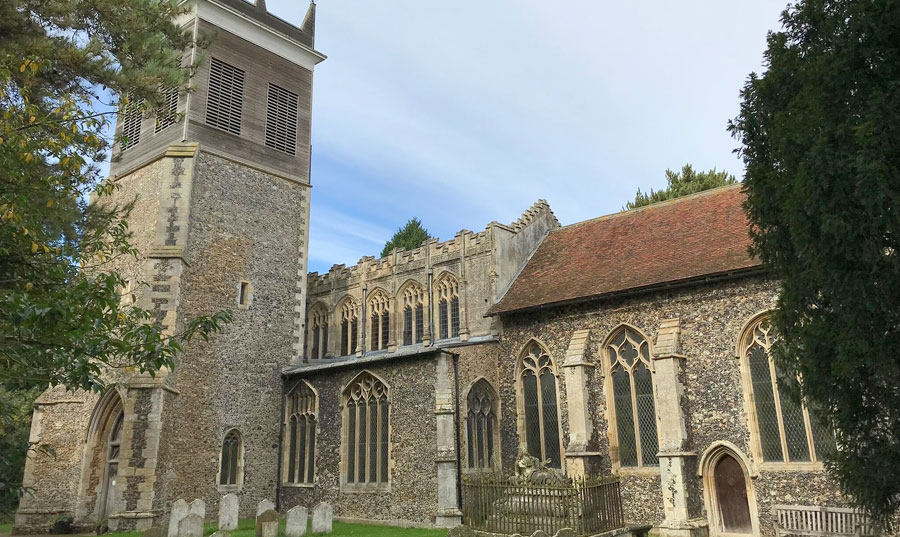
St. Mary & St. Lambert
Stonham, Aspal, Suffolk IP14 6AG
The Church of St. Mary & St. Lambert, Stonham Aspal is a Grade I listed building in the United Kingdom. This is a unique double dedication and only other English Church (at Burnaston in Yorkshire) is dedicated to St. Lambert, who was the Evangelist Bishop of Maastricht, martyred in ca. 705.
St. Mary & St. Lambert is fine example of a mediaeval stone & flint church. Much of the fabric of the church dates from the 14th century, although the core of the chancel may be earlier. The Font bowl and the effigy of a knight in the chancel are 13th century and there was probably a church on this spot long before then. During the 15th century several of the windows were replaced, the nave was widened southwards, the clerestory and the north porch were erected.
The tower received its wooden top stage between 1742-1745 and between 1871-1873 the church underwent a restoration. During this time the chancel ceiling was removed and many of its roof timbers were renewed, the windows throughout the church were renovated and a new window was placed in the south aisle. The mediaeval bench-ends were restored and matching new benches were made to replace the box pews. The west gallery was removed and the three decker pulpit cut down and placed on the south side. A new vestry and organ chamber were built to the north of the chancel.
The square tower, which is unusual because of its position and its unexpected wooden belfry stage. This tower is not at the western end of the church, but its base forms the south porch. It is strengthened by diagonal buttresses at the southern corners and the entrance arch is flanked by corbels in the shape of human faces. The lower stage is lit by a renewed two- light window on the eastern side and the ringing chamber has small rectangular windows. There was at one time a fine wooden clock – face on the southern side.
The 19th century vestry runs the entire length of the chancel and has its own outside entrance.
The chancel has a pair of double windows, of late 14th century, a restored three light window and a small renewed priest’s doorway. Carved on the westernmost chancel butress are two mediaeval scratch – dials, also another on the central butress. These indicated the times of services before the days of clocks.
In the church yard nearby is the magnificent tomb of Rev. Anthony Wingfield, who died on 11 November 1714. Rev. Anthony was the son of Anthony Wingfield (1671-1730) and Mary Blomfield. The effigy of Rev. Anthony was carved by Francis Bird, a former pupil of the renowned Grinling Gibbons, and who was responsible for the statues of Dr. Bushy in Westminster Abbey and of Queen Anne, outside St. Paul’s Cathedral. The full-length figure of Rev. Anthony Wingfield is shown reclining Roman-style, in full Georgian dress on a 6 ft. plinth surrounded by railings. Sadly, in the 1960’s the snake, an asp, that he was holding was unfortunately stolen.

Above the south doorway hangs a funeral hatchment and opposite, above the north doorway, are Royal Arms of King George III. The north door itself is mediaeval, but its other side cannot be seen because standing in front of it is a table, the top of which is the Jacobean sounding board, dated 1616, of a once three decker pulpit.
The octagonal font bowl dates from the 13th century and has single shallow trefoil headed arches.
In the nave are 15th century poppyhead bench ends. These have been placed near the center aisle and the others were carved during the 1870s restoration to match them. The arm-rests are carved with a fascinating array of animals, mythological creatures and human figures. Among the mediaeval arm-rests can be seen a wolf guarding the head of St. Edmund (2nd from east, south aisle). At the western end of the north and south aisles are some 17th century bench ends, which are less elaborately carved.
The Church possess several memorials of people of the past who have been associated with it. One be seen in the arched recess in the north wall of the sanctuary, a broken effigy of a knight in armor. The knight was a member of the Aspal family and may have been Sir John de Aspal, who in 1348, held no less than six Suffolk manors. The effigy dates from about this time, or possibly a little earlier. The face is beautifully preserved and the head rests upon a double cushion.
The Church at one time possessed three chapels; the one at the east end of the south aisle was dedicated to St. Anne, and its piscina still remains, beneath a charmfered arch. Opposite, in the north aisle, was the chapel of St. Lambert. The piscina here is in the north face of the eastern pier but this is now obscured by the organ. A third chapel stood to the north of the chancel, where the present vestry is now situated.
There were several brasses at one time in this church. The indents for two of these can be seen in the stone burial slabs near the vestry door. One had the effigy of a woman, an inscription and a tiny group of three children. The remaining brass lies beneath the western arch of the north arcade and commemorates the Rev. John Metcalf, Rector of this parish from 1571- 1612. It shows his effigy in half profile, wearing a ruff, a long preaching-gown with hanging sleeves, and a scarf. Beneath is a Latin inscription.
Near the priest’s door are two black ledger slabs, commemorating the Rev. Robert Baynes, Rector of this parish, who died in 1783, and his wife and other members of his family.